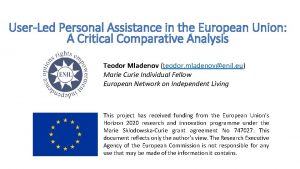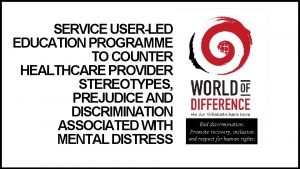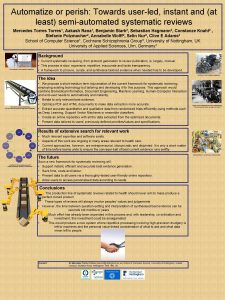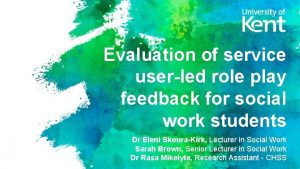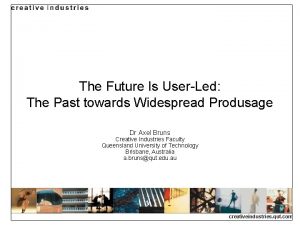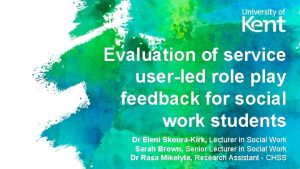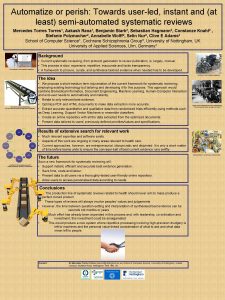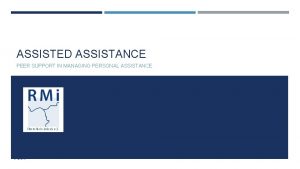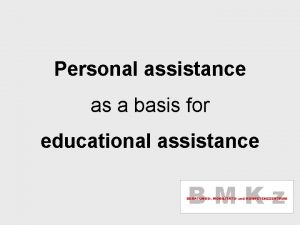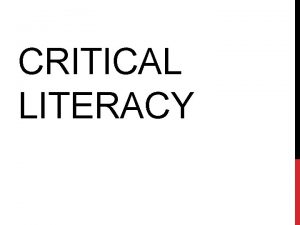UserLed Personal Assistance in the EU A Critical














- Slides: 14

User-Led Personal Assistance in the EU: A Critical Comparative Analysis Teodor Mladenov (teomladenov@gmail. com) Senior Lecturer, School of Education and Social Work, University of Dundee This project has received funding from the European Union’s Horizon 2020 research and innovation programme under the Marie Sklodowska-Curie grant agreement No 747027. This document reflects only the author’s view. The Research Executive Agency of the European Commission is not responsible for any use that may be made of the information it contains.

AIM to compare and assess PA schemes in the EU from the perspective of the independent living philosophy and the social model of disability APPROACH participatory approach – involve PA users and independent living activists at key stages of implementation METHODS a survey and a checklist

PA SURVEY – content Instruction: Please, evaluate each statement on a scale from -3 to +3, where: • -3 means that what is described HINDERS users’ choice and control to maximum extent • 0 means that what is described NEITHER HINDERS NOR ENABLES user’s choice and control • +3 means that what is described ENABLES users’ choice and control to maximum extent Exemplary statements (138 in total): Statements The [PA] scheme is codified in a separate national law. The [PA] scheme is funded by the state, out of the state budget (centralised funding). The needs assessment is led by the user, possibly aided by peers. The users can keep their assistance when moving to another country. The wages of the assistants are protected by minimum wage regulations. -3 -2 -1 0 +1 +2 +3

PA SURVEY – implementation Period: 19 January – 4 March 2018 Platform: Google Forms Dissemination: email and ENIL’s newsletter Response: 54 completed questionnaires returned • 35 (65%) ‘personal assistance users’ Results: ‘What is good personal assistance made of? Results of a European survey’ (Disability & Society, 2019)

PA SURVEY – geographical coverage • • • • • • Armenia (1) Austria (1) Belgium (3) Bulgaria (4) Estonia (1) France (2) Greece (4) Hungary (4) Ireland (1) Italy (1) Luxembourg (1) Malta (1) Montenegro (2) Norway (3) Netherlands (2) Romania (2 Serbia (3) Spain (1) Sweden (1) Switzerland (1) United Kingdom (8)

PA SURVEY – top 10 enablers 1. The users can choose their personal assistants. 2. The assistants are protected by health and safety provisions. 3. The appeal procedure [that enables the users to contest the outcome of the needs assessment] is straightforward, transparent and does not entail additional expenses for the user. 4. The scheme is provided irrespective of family (including marital) situation. 5. The users can keep their assistance when moving to another region or local authority within the country. 6. The users of the scheme have the opportunity to appeal the outcome of their assessments. 7. Under the scheme, the user determines the times when assistance will be provided, including during nights, weekends, holidays, etc. 8. The scheme is underpinned by the Independent Living philosophy and/or the social model of disability. 9. The users can dismiss their personal assistants. 10. The provision of personal assistance under the scheme is recognised as a (human, civil, social) right. mean +2. 41 +2. 30 +2. 28 +2. 22 +2. 20 +2. 19 +2. 17

mean PA SURVEY – top 10 barriers -2. 31 1. The assistants are appointed by the provider, without the involvement of the user. 2. Under the scheme, assistance is bound to a location (for example, it is provided only -2. 30 at the user’s home). 3. The scheme deteriorates by incorporating measures that restrict the choice and -2. 15 control of the users. 4. The scheme is limited by a ‘cost ceiling’ and users whose support costs more are -2. 13 directed towards traditional services (e. g. , residential institutions). -2. 00 5. The scheme is used as an excuse for cutting expenses for ‘social care’. 6. Policy makers and other stakeholders (e. g. , the media) misunderstand, misuse or -1. 98 misrepresent the scheme. 7. Assistants are not allowed to perform tasks related to health care (even after -1. 91 delegation or approval by medical professionals). -1. 83 8. Under the scheme, assistants work fixed hours (e. g. , from 9: 00 AM till 5: 00 PM). 9. The scheme is subjected to cuts (e. g. , eligibility is tightened, ‘assistance hours’ are -1. 80 reduced, conditionality is introduced, etc. ). -1. 59 10. There is a pre-defined list of tasks that the assistants can do.

PA CHECKLIST – development Of the 138 characteristics in the PA survey, 61 were retained based on: • their mean score – larger than +0. 8 or smaller than -0. 8, • at 95% confidence level, • using the Bonferroni correction.

PA CHECKLIST – implementation Period: November 2018 – December 2018 Dissemination: 17 independent living experts and PA users from 11 European countries: Belgium (including Flanders and Wallonia), Bulgaria, Croatia, Ireland, Italy, Norway, Serbia, Slovenia, Spain, Sweden, and the United Kingdom Response: 10 completed checklists from 8 European countries: Belgium (Flanders), Bulgaria, Ireland, Serbia, Slovenia, Spain, Sweden, and the United Kingdom

Country, region PA scheme Belgium, Personal Following Budget Flanders Bulgaria, Assistant for Independent Living Sofia Mean Coverage score Context Mean score by dimension Needs Working Funding Provision assessment conditions regional 0. 30 -0. 23 1. 05 0. 89 -0. 94 0. 73 local -0. 71 / -0. 91 -0. 69 / -1. 30 -1. 87 / -1. 87 0. 23 / 0. 20 -0. 05 / -0. 24 -1. 19 / -1. 33 national -0. 61 -1. 60 0. 06 -1. 32 -0. 18 -0. 03 national 1. 13 1. 98 -1. 14 1. 41 1. 43 1. 97 national 1. 03 0. 88 -1. 14 1. 73 2. 05 1. 64 Pilot Project of Andalucía Independent Living regional 0. 03 0. 76 -1. 87 0. 52 0. 98 -0. 23 Sweden Personal Assistance Direct Payment national 1. 34 0. 64 1. 87 0. 18 2. 08 1. 96 United Kingdom Direct Payment – Personal Budget national (local funding) -0. 42 -1. 33 -0. 43 -0. 02 0. 10 Ireland Serbia Health Service Executive Scheme Personal Assistance Service Slovenia Independent Living Spain,

PA CHECKLIST – Sweden Country, region Sweden PA scheme Personal Assistance Direct Payment Coverage Mean score national 1. 34 Context 0. 64 Mean score by dimension Funding Needs Provision Working assessment conditions 1. 87 0. 18 2. 08 1. 96 Swedish expert’s comment: ‘ 80% of new applications [for PA under the scheme in Sweden] are currently turned down’

PA CHECKLIST – Bulgaria CHARACTERISTICS OF PA 10. The scheme ‘frees’ family members from ‘caring’ obligations, enabling them to undertake other activities. Mean Sch. 1 Sch. 2/2 Sch. 3 Sch. 4 Sch. 5 Sch. 6 Sch. 7 Sch. 8 score Belgium Bulgaria Ireland Serbia Slovenia Spain Sweden UK 1. 69 Neither False Neither True True Bulgarian experts’ comments: • ‘the rate of payment (less than € 2 per hour) does not allow the users to hire assistants on the labour market’ • ‘[i]n 95 % of the cases parents or relatives of people with disabilities become their PA which prevents them to have free choice and to live independently’

PA CHECKLIST – cuts CHARACTERISTICS OF PA 5. The scheme is subjected to cuts (e. g. , eligibility is tightened, ‘assistance hours’ are reduced, conditionality is introduced, etc. ). Mean Sch. 1 Sch. 2/2 Sch. 3 score Belgium Bulgaria Ireland -1. 80 True Sch. 4 Sch. 5 Sch. 6 Sch. 7 Sch. 8 Serbia Slovenia Spain Sweden UK Neither True We urge decision makers at national and EU levels to reverse the cuts to PA!

More information about the PA survey: Mladenov, T. (2019) ‘What is good personal assistance made of? Results of a European survey’, Disability & Society. DOI: 10. 1080/09687599. 2019. 1621740 https: //www. tandfonline. com/doi/full/10. 1080/09687599. 2019. 1621740 More information about the PA checklist: Mladenov, T. , Pokern, Y. and Cojocariu, I. B. (2019) PA Checklist – A Tool for Assessing Personal Assistance Schemes. Brussels: European Network on Independent Living. https: //enil. eu/wp-content/uploads/2019/02/Mladenov_Pokern_Bulic-PA_Checklist. pdf Drop me a message: Teodor Mladenov, teomladenov@gmail. com
 Critical semi critical and non critical instruments
Critical semi critical and non critical instruments Spaulding classification
Spaulding classification Slidetodoc.com
Slidetodoc.com Phản ứng thế ankan
Phản ứng thế ankan Thiếu nhi thế giới liên hoan
Thiếu nhi thế giới liên hoan Vẽ hình chiếu vuông góc của vật thể sau
Vẽ hình chiếu vuông góc của vật thể sau Alleluia hat len nguoi oi
Alleluia hat len nguoi oi điện thế nghỉ
điện thế nghỉ Một số thể thơ truyền thống
Một số thể thơ truyền thống Hệ hô hấp
Hệ hô hấp Số.nguyên tố
Số.nguyên tố Công thức tính độ biến thiên đông lượng
Công thức tính độ biến thiên đông lượng đặc điểm cơ thể của người tối cổ
đặc điểm cơ thể của người tối cổ Tỉ lệ cơ thể trẻ em
Tỉ lệ cơ thể trẻ em Các châu lục và đại dương trên thế giới
Các châu lục và đại dương trên thế giới















